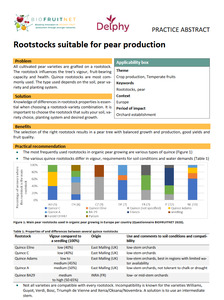{Tool} Rootstocks suitable for pear production (BIOFRUITNET Practice Abstract). Creator(s): Brouwer, Gerjan. Issuing Organisation(s): Delphy. Biofruitnet Practice Abstract, no. 063. (2023)
|
PDF
- Published Version
- English
(Rootstocks suitable for pear production)
359kB | |
|
PDF
- Published Version
- Dutch/Nederlands
(Onderstammen voor peren)
355kB | |
|
PDF
- Published Version
- German/Deutsch
(Geeignete Unterlagen für den ökologischen Birnenanbau)
361kB | |
![[thumbnail of 2024-09-16 16_45_49-Rootstocks suitable for pear production - 63PA_R4.pdf – Mozilla Firefox.png]](/45949/7.hassmallThumbnailVersion/2024-09-16%2016_45_49-Rootstocks%20suitable%20for%20pear%20production%20-%2063PA_R4.pdf%20%E2%80%93%20Mozilla%20Firefox.png)  Preview |
Image (PNG)
- Cover Image
- English
111kB |
Document available online at: https://orgprints.org/45949
Summary in the original language of the document
The selection of the right rootstock results in a pear tree with balanced growth and production, good yields and fruit quality.
Practical recommendation
• The most frequently used rootstocks in organic pear growing are various types of quince
• The various quince rootstocks differ in vigour, requirements for soil conditions and water demands
• Not all varieties are compatible with every rootstock. Incompatibility is known for the varieties Williams, Guyot, Verdi, Bosc, Triumph de Vienne and Xenia/Oksana/Novembra. A solution is to use an intermediate stem.
• Doyenné du Comice (=Vereindechant) fits any rootstock and is, therefore good to use as an intermediate stem
• The rootstock Eline® leads to the production of pears with less bronze colour (smoother pears) than rootstocks MC, Adams, C132 and MH (Maas 2014)
• Adams is the most productive rootstock under growth conditions in which no or limited water and fertigation can be applied
• Frost sensitivity is an important factor. Quince Eline is less susceptible than other Quince rootstocks
• New rootstocks with resistance to various diseases should be tested under organic circumstances.
| EPrint Type: | Practice tool |
|---|---|
| What problem does the tool address?: | All cultivated pear varieties are grafted on a rootstock. The rootstock influences the tree's vigour, fruit-bearing capacity and health. Quince rootstocks are most commonly used. The type used depends on the soil, pear variety and planting system. |
| What solution does the tool offer?: | Knowledge of differences in rootstock properties is essential when choosing a rootstock-variety combination. It is important to choose the rootstock that suits your soil, variety choice, planting system and desired growth. |
| Country: | Netherlands |
| Type of Practice Tool: | Practice abstracts |
| Keywords: | Rootstocks, pear |
| Agrovoc keywords: | Language Value URI English rootstocks http://aims.fao.org/aos/agrovoc/c_6653 English pears http://aims.fao.org/aos/agrovoc/c_5645 |
| Subjects: | Crop husbandry > Production systems > Fruit and berries |
| Research affiliation: | European Union > Horizon 2020 > Biofruitnet Netherlands > Other organizations Netherlands European Union > Organic Farm Knowledge |
| Horizon Europe or H2020 Grant Agreement Number: | 862850 |
| Related Links: | https://organic-farmknowledge.org/tool/45949, https://biofruitnet.eu |
| Project ID: | ofk |
| Deposited By: | Basler, Andreas |
| ID Code: | 45949 |
| Deposited On: | 26 Apr 2023 08:41 |
| Last Modified: | 16 Sep 2024 14:46 |
| Document Language: | English, German/Deutsch, Dutch/Nederlands |
| Status: | Published |
Repository Staff Only: item control page

 Download Statistics
Download Statistics Download Statistics
Download Statistics
